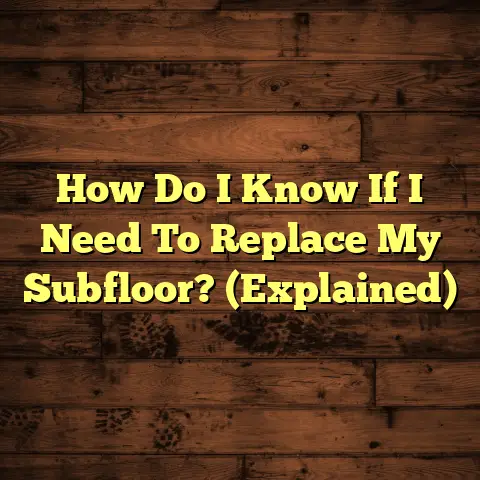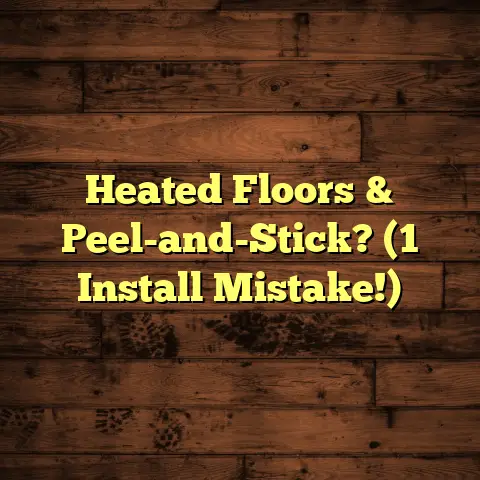Fix Warped Wood Floors From Water? (4 Steps NOW!)
Ignoring warped wood floors can lead to disastrous consequences for your home, but with the right approach, you can restore them to their former glory in just four simple steps! And believe me, I’ve seen it all in my years as a flooring contractor.
Section 1: Understanding the Problem
Definition of Warped Wood Floors
So, what exactly are warped wood floors?
Basically, it’s when your beautiful, flat wood flooring starts to deform, usually because of moisture.
Think of it like a sponge that’s been soaked in water; it swells and changes shape.
Warping can manifest in several ways, impacting both the look and feel of your floors. It’s not just an eyesore, though.
Left unchecked, it can affect the structural integrity of your floor and even lead to safety hazards.
Causes of Warping
Water, water everywhere… and sometimes, unfortunately, in your wood floors.
Water exposure is the primary culprit behind warping. This can come from a variety of sources:
-
Leaks: A leaky pipe, a dripping faucet, or even a small roof leak can introduce moisture.
-
Spills: Accidental spills that aren’t cleaned up promptly can seep into the wood.
-
Humidity: High humidity levels, especially in basements or poorly ventilated areas, can cause wood to absorb moisture from the air.
-
Flooding: In severe cases, flooding can saturate the wood, leading to significant warping.
I’ve seen firsthand the devastation that even a small, undetected leak can cause.
According to the EPA, indoor humidity levels should be between 30-50% to prevent moisture-related issues.
Ignoring this can lead to problems far beyond just warped floors.
Signs of Warping
How do you know if your wood floors are warped? Look out for these telltale signs:
-
Buckling: This is when the edges of the boards lift up, creating a wave-like effect.
-
Cupping: The edges of the boards rise higher than the center, creating a concave shape.
-
Crowning: The opposite of cupping, where the center of the board rises higher than the edges, forming a convex shape.
-
Gaps: Excessive gaps between the boards can indicate that the wood has expanded and contracted due to moisture.
-
Squeaking: Warped floors can often squeak when you walk on them due to the uneven surface.
(Insert image here showcasing buckling, cupping, and crowning)
Run your hand across the floor; do you feel any unevenness?
Pay attention to areas near water sources like bathrooms, kitchens, and entryways.
These are often the first places to show signs of warping.
Section 2: Assessing the Damage
Inspection Techniques
Okay, so you suspect you have warped floors. Now what?
A thorough inspection is crucial to understanding the extent of the damage and determining the best course of action.
Here’s how I approach an inspection:
-
Visual Inspection: Start by carefully examining the entire floor, paying close attention to areas where you suspect water damage.
-
Check for Mold: Look for any signs of mold or mildew, especially in dark or damp areas. Mold can be a serious health hazard, so it’s important to address it promptly.
-
Subfloor Integrity: Check the subfloor for any signs of rot or damage. The subfloor is the foundation of your flooring, and if it’s compromised, it will need to be repaired or replaced.
-
Moisture Meter: Use a moisture meter to measure the moisture content of the wood. A reading above 12% indicates excessive moisture.
-
Sound Test: Tap on the floor in different areas. A hollow sound can indicate that the wood has separated from the subfloor.
Tools Needed for Inspection
To conduct a proper inspection, you’ll need a few essential tools:
-
Moisture Meter: This is crucial for determining the moisture content of the wood. (~$30-$100)
-
Level: Use a level to check for unevenness in the floor. (~$10-$30)
-
Flashlight: A flashlight will help you see into dark corners and under furniture. (~$5-$20)
-
Screwdriver/Pry Bar: For lifting up sections of the floor to inspect the subfloor (if necessary). (~$10-$20)
-
Camera: Documenting the damage with photos will be helpful for insurance claims or when consulting with a professional.
Documenting the Damage
As you inspect, take detailed notes and photos of everything you find.
This documentation will be invaluable when planning your repair strategy and can also be helpful if you need to file an insurance claim.
Be sure to include:
- Photos of the warped areas
- Moisture meter readings
- Notes on the condition of the subfloor
- Any signs of mold or mildew
- The location of any leaks or water sources
Section 3: The Four-Step Repair Process
Alright, you’ve assessed the damage. Now it’s time to get to work!
Here’s my tried-and-true four-step process for repairing warped wood floors:
Step 1: Remove Excess Moisture
The first and most crucial step is to remove any excess moisture from the wood and surrounding area.
If you don’t address the source of the moisture, the warping will only get worse.
Here’s how to tackle moisture removal:
-
Identify and Stop the Source: This is paramount. Fix any leaks, repair plumbing issues, or address any other sources of water intrusion.
-
Ventilation: Open windows and doors to increase airflow and help the wood dry out.
-
Fans: Use fans to circulate air and speed up the drying process. Place fans strategically to blow air across the affected areas.
-
Dehumidifiers: Dehumidifiers are incredibly effective at removing moisture from the air. Place them in the affected area and run them continuously until the moisture content of the wood returns to normal.
-
Absorbent Materials: Place towels or absorbent materials on the affected areas to soak up excess water. Change them frequently as they become saturated.
Important Note: Avoid using heat guns or direct heat sources to dry the wood, as this can cause further damage and cracking.
Step 2: Repairing or Replacing Damaged Boards
Once the wood is dry, you can assess whether to repair or replace the warped boards.
Repairing Damaged Boards:
For minor warping, you may be able to repair the boards without replacing them. Here are a few techniques:
-
Sanding: If the warping is slight, you can sand down the high spots to create a level surface. Use a belt sander with progressively finer grits of sandpaper.
-
Wood Filler: For small gaps or imperfections, use wood filler to fill in the voids. Choose a wood filler that matches the color of your flooring.
-
Clamping: For boards that are slightly lifted, you can try clamping them down to the subfloor. Use wood glue to adhere the board to the subfloor, then clamp it in place until the glue dries.
Replacing Damaged Boards:
If the warping is severe, or if the boards are cracked or rotted, you’ll need to replace them.
Here’s how to replace damaged boards:
-
Select Matching Wood: Choose replacement boards that match the species, color, and grain of your existing flooring.
-
Cut the Damaged Board: Carefully cut out the damaged board using a circular saw or a multi-tool. Be careful not to damage the surrounding boards.
-
Prepare the Subfloor: Clean the subfloor and remove any debris.
-
Install the New Board: Apply wood glue to the subfloor and position the new board in place. Use nails or screws to secure the board to the subfloor.
-
Finishing: Sand the new board smooth and apply stain and finish to match the existing flooring.
(Insert image here showing how to replace a damaged board)
Step 3: Preventing Future Moisture Issues
Once you’ve repaired or replaced the damaged boards, it’s crucial to take steps to prevent future moisture problems.
Here are some preventative measures you can take:
-
Maintain Indoor Humidity Levels: Use a humidifier or dehumidifier to maintain indoor humidity levels between 30-50%.
-
Seal Gaps in Plumbing: Seal any gaps or cracks around plumbing fixtures to prevent water from seeping into the subfloor.
-
Improve Ventilation: Ensure adequate ventilation in areas prone to moisture, such as bathrooms and basements.
-
Regular Maintenance Checks: Regularly inspect your floors for any signs of water damage or warping. Address any issues promptly to prevent them from worsening.
-
Quality Underlayment: When installing new flooring, choose a high-quality underlayment that provides a moisture barrier.
Step 4: Finishing Touches
After repairing or replacing the damaged boards, it’s time to restore the flooring’s aesthetic appeal.
Here are some finishing touches you can consider:
-
Refinishing: If the repaired area doesn’t match the existing flooring, you may need to refinish the entire floor. This involves sanding down the old finish and applying a new coat of stain and sealant.
-
Staining: If you’ve replaced boards, you’ll need to stain them to match the existing flooring. Choose a stain that closely matches the color of your flooring and apply it evenly.
-
Sealing: Apply a sealant to protect the wood from moisture and wear. Choose a sealant that is appropriate for your type of flooring and apply it according to the manufacturer’s instructions.
(Insert image here showcasing the refinishing process)
Section 4: Long-term Care and Maintenance
Routine Maintenance Tips
To keep your wood floors looking their best and prevent future warping, follow these routine maintenance tips:
-
Sweep or Vacuum Regularly: Sweep or vacuum your floors regularly to remove dirt and debris.
-
Clean with a Damp Mop: Clean your floors with a damp mop and a wood floor cleaner. Avoid using excessive water, as this can damage the wood.
-
Use Protective Mats: Place protective mats at entryways to prevent dirt and moisture from being tracked onto the floors.
-
Avoid Harsh Chemicals: Avoid using harsh chemicals or abrasive cleaners on your wood floors, as these can damage the finish.
Dealing with Humidity
Managing indoor humidity levels is crucial for preventing warped wood floors.
Here are some tips for dealing with humidity:
-
Use a Dehumidifier: Use a dehumidifier in areas prone to moisture, such as basements and bathrooms.
-
Improve Ventilation: Improve ventilation in your home by opening windows and doors or using exhaust fans.
-
Seal Windows and Doors: Seal any gaps or cracks around windows and doors to prevent moisture from entering your home.
-
Monitor Humidity Levels: Use a hygrometer to monitor indoor humidity levels and adjust your humidity control measures accordingly.
Conclusion
Warped wood floors can be a major headache, but with the right approach, you can restore them to their former glory.
Remember to act quickly to address any signs of water damage or warping, and follow the four steps outlined in this article:
- Remove Excess Moisture
- Repairing or Replacing Damaged Boards
- Preventing Future Moisture Issues
- Finishing Touches
With a little bit of effort and the right tools, you can keep your wood floors looking beautiful and functional for years to come.
Call to Action
Have you ever dealt with warped wood floors? I’d love to hear about your experiences!
Share your tips and tricks in the comments below, or reach out to me directly for further assistance.
Let’s work together to keep our floors looking their best!





